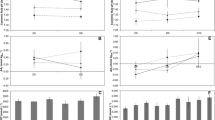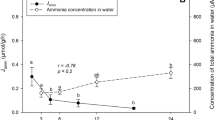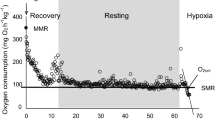Abstract
Background
The iono- and osmoregulatory capacities of marine teleosts, such as European sea bass (Dicentrarchus labrax) are expected to be challenged by high carbon dioxide exposure, and the adverse effects of elevated CO2 could be amplified when such fish migrate into less buffered hypo-osmotic estuarine environments. Therefore, the effects of increased CO2 on the physiological responses of European sea bass (Dicentrarchus labrax) acclimated to 32 ppt, 10 ppt and 2.5 ppt were investigated.
Methods
Following acclimation to different salinities for two weeks, fish were exposed to present-day (400 µatm) and future (1000 µatm) atmospheric CO2 for 1, 3, 7 and 21 days. Blood pH, plasma ions (Na+, K+, Cl-), branchial mRNA expression of ion transporters such as Na+/K+–ATPase (NKA), Na+/K+/2Cl– co-transporters (NKCC) and ammonia transporters (e.g. Rhesus glycoproteins Rhbg, Rhcg1 and Rhcg2) were examined to understand the iono- and osmoregulatory consequences of elevated CO2.
Results
A transient but significant increase in the blood pH of exposed fish acclimated at 10 ppt (day 1) and 2.5 ppt (day 21) was observed possibly due to an overshoot of the blood HCO3− accumulation while a significant reduction of blood pH was observed after 21 days at 2.5ppt. However, no change was seen at 32 ppt. Generally, Na + concentration of control fish was relatively higher at 10 ppt and lower at 2.5 ppt compared to 32 ppt control group at all sampling periods. Additionally, NKA was upregulated in gill of juvenile sea bass when acclimated to lower salinities compared to 32 ppt control group. CO2 exposure generally downregulated NKA mRNA expression at 32ppt (day 1), 10 ppt (days 3, 7 and 21) and 2.5ppt (days 1 and 7) and also a significant reduction of NKCC mRNA level of the exposed fish acclimated at 32 ppt (1–3 days) and 10 ppt (7–21 days) was observed. Furthermore, Rhesus glycoproteins were generally upregulated in the fish acclimated at lower salinities indicating a higher dependance on gill ammonia excretion. Increased CO2 led to a reduced expression of Rhbg and may therefore reduce ammonia excretion rate.
Conclusion
Juvenile sea bass were relatively successful in keeping acid base balance under an ocean acidification scenario. However, this came at a cost for ionoregulation with reduced NKA, NKCC and Rhbg expression rates as a consequence.







Similar content being viewed by others
Data availability
All data generated or analyzed during this study are included in this published article and its supplementary information files.
Code availability
Not applicable.
References
Doney SC (2010) The growing human footprint on coastal and open-ocean biogeochemistry. Science 328:1512–1516. https://doi.org/10.1126/science.1185198
Franke A, Clemmesen C (2011) Effect of ocean acidification on early life stages of Atlantic herring (Clupea harengus L). Biogeosciences Discuss 8:7097–7126. https://doi.org/10.5194/bg-8-3697-2011
Lönnstedt OM, Munday PL, McCormick MI, Ferrari MCO, Chivers DP (2013) Ocean acidification and responses to predators: can sensory redundancy reduce the apparent impacts of elevated CO2 on fish? Ecol Evol. 3:3565–3575. https://doi.org/10.1002/ece3.684
Bresolin de Souza K, Jutfelt F, Kling P, Förlin L, Sturve J (2014) Effects of increased CO2 on fish gill and plasma proteome. PLoS ONE 9:e102901. https://doi.org/10.1371/journal.pone.0102901
Green L, Jutfelt F (2014) Elevated carbon dioxide alters the plasma composition and behaviour of a shark. Biol Lett 10:20140538. https://doi.org/10.1098/rsbl.2014.0538
Azevedo LB, De Schryver AM, Hendriks AJ, Huijbregts MAJ (2015) Calcifying species sensitivity distributions for ocean acidification. Environ Sci Technol 49:1495–1500. https://doi.org/10.1021/es505485m
Checkley DM, Dickson AG, Takahashi M, Radich JA, Eisenkolb N, Asch R (2009) Elevated CO2 enhances otolith growth in young fish. Science 324:1683. https://doi.org/10.1126/science.1169806
Doney SC, Fabry VJ, Feely RA, Kleypas JA (2009) Ocean Acidification: the other CO2 problem. Ann Rev Mar Sci 1:69–92. https://doi.org/10.1146/annurev.marine.010908.163834
Logan CA (2010) A review of Ocean Acidification and America’s response. Bioscience 60:819–828. https://doi.org/10.1525/bio.2010.60.10.8
Esbaugh AJ (2017) Physiological implications of ocean acidification for marine fish: emerging patterns and new insights. J Comp Physiol B 188:1–13. https://doi.org/10.1007/s00360-017-1105-6
Hurst TP, Fernandez ER, Mathis JT (2013) Effects of ocean acidification on hatch size and larval growth of walleye pollock (Theragra chalcogramma). ICES J Mar Sci 70:812–822. https://doi.org/10.1093/icesjms/fst053
Kreiss CM, Michael K, Lucassen M, Jutfelt F, Motyka R, Dupont S, Pörtner HO (2015) Ocean warming and acidification modulate energy budget and gill ion regulatory mechanisms in Atlantic Cod (Gadus morhua). J Comp Physiol B Biochem Syst Environ Physiol 185:767–781. https://doi.org/10.1007/s00360-015-0923-7
Kwan GT, Hamilton TJ, Tresguerres M (2017) CO2-induced ocean acidification does not affect individual or group behaviour in a temperate damselfish. R Soc Open Sci 4:170283. https://doi.org/10.1098/rsos.170283
IPCC (2013) Summary for Policymakers. Clim Chang 2013 Phys Sci Basis Contrib Work Gr I to Fifth Assess Rep Intergov Panel Clim Chang 33
Magill SH, Sayer MDJ (2004) The effect of reduced temperature and salinity on the blood physiology of juvenile Atlantic Cod. J Fish Biol 64:1193–1205. https://doi.org/10.1111/j.0022-1112.2004.00383.x
Sinha AK, Dasan AF, Rasoloniriana R, Pipralia N, Blust R, De Boeck G (2015) Hypo-osmotic stress-induced physiological and ion-osmoregulatory responses in European sea bass (Dicentrarchus labrax) are modulated differentially by nutritional status. Comp Biochem Physiol -Part Mol Integr Physiol 181:87–99. https://doi.org/10.1016/j.cbpa.2014.11.024
Sinha AK, Liew HJ, Diricx M, Blust R, De Boeck G (2012) The interactive effects of ammonia exposure, nutritional status and exercise on metabolic and physiological responses in gold fish (Carassius auratus L). Aquat Toxicol 109:33–46. https://doi.org/10.1016/j.aquatox.2011.11.002
Kultz D (2015) Physiological mechanisms used by fish to cope with salinity stress. J Exp Biol 218:1907–1914. https://doi.org/10.1242/jeb.118695
Edwards SL, Marshall WS (2012) Principles and patterns of osmoregulation and euryhalinity in fishes. In Fish physiology. Acad Press 32:1–44. https://doi.org/10.1016/B978-0-12-396951-4.00001-3
Dixson DL, Munday PL, Jones GP (2010) Ocean acidification disrupts the innate ability of fish to detect predator olfactory cues. Ecol Lett 13:68–75. https://doi.org/10.1111/j.1461-0248.2009.01400.x
Baumann H, Talmage SC, Gobler CJ (2012) Reduced early life growth and survival in a fish in direct response to increased carbon dioxide. Nat Clim Chang 2:38–41. https://doi.org/10.1038/nclimate1291
Briffa M, de la Haye K, Munday PL (2012) High CO2 and marine animal behaviour: potential mechanisms and ecological consequences. Mar Pollut Bull 64:1519–1528. https://doi.org/10.1016/j.marpolbul.2012.05.032
Frommel AY, Maneja R, Lowe D, Malzahn AM et al (2012) Severe tissue damage in Atlantic Cod larvae under increasing ocean acidification. Nat Clim Chang 2:42–46. https://doi.org/10.1038/nclimate1324
Jutfelt F, Bresolin de Souza K, Vuylsteke A, Sturve J (2013) Behavioural disturbances in a temperate fish exposed to sustained high-CO2 levels. PLoS ONE 8:6–11. https://doi.org/10.1371/journal.pone.0065825
Heuer RM, Grosell M (2014) Physiological impacts of elevated carbon dioxide and ocean acidification on fish. AJP Regul Integr Comp Physiol 307:R1061–R1084. https://doi.org/10.1152/ajpregu.00064.2014
Ishimatsu A, Kikkawa T, Hayashi M, Lee KS, Kita J (2004) Effects of CO2 on Marine Fish: larvae and adults. J Oceanogr 60:731–741. https://doi.org/10.1007/s10872-004-5765-y
Evans DH, Piermarini PM, Choe KP (2005) The multifunctional fish gill: dominant site of gas exchange, osmoregulation, acid-base regulation, and excretion of nitrogenous waste. Physiol Rev 85:97–177. https://doi.org/10.1152/physrev.00050.2003
Ishimatsu A, Hayashi M, Lee KS, Kikkawa T, Kita J (2005) Physiological effects on fishes in a high-CO2 world. J Geophys Res C Ocean 110:1–8. https://doi.org/10.1029/2004JC002564
Zadunaisky JA (1996) Chloride cells and osmoregulation. Kidney Int 49(6):1563–1567. https://doi.org/10.1038/ki.1996.225
Claiborne JB, Edwards SL, Morrison-Shetlar AI (2002) Acid-base regulation in fishes: cellular and molecular mechanisms. J Exp Zool 293:302–319. https://doi.org/10.1002/jez.10125
Perry SF, Gilmour KM (2006) Acid-base balance and CO2 excretion in fish: unanswered questions and emerging models. Respir Physiol Neurobiol 154:199–215. https://doi.org/10.1016/j.resp.2006.04.010
Shrivastava J, Ndugwa M, Caneos W, De Boeck G (2019) Physiological trade-offs, acid-base balance and ion-osmoregulatory plasticity in European sea bass (Dicentrarchus labrax) juveniles under complex scenarios of salinity variation, ocean acidification and high ammonia challenge. Aquat Toxicol 212:54–69. https://doi.org/10.1016/j.aquatox.2019.04.024
Marshall WS, Grosell M (2006) Ion transport, osmoregulation, and acid–base balance. Physiol Fishes 3:179–214
Hiroi J, Yasumasu S, Mccormick SD, Hwang P, Kaneko T (2008) Evidence for an apical Na–Cl cotransporter involved in ion uptake in a teleost fish. 2584–2599. https://doi.org/10.1242/jeb.018663
Hsu H, Lin L, Tseng Y (2014) A new model for fish ion regulation: identification of ionocytes in freshwater- and seawater-acclimated medaka (Oryzias latipes). Cell Tissue Res 357:225–243. https://doi.org/10.1007/s00441-014-1883-z
Hwang PP, Lee TH, Lin LY (2011) Ion regulation in fish gills: recent progress in the cellular and molecular mechanisms. AJP Regul Integr Comp Physiol 301:R28–R47. https://doi.org/10.1152/ajpregu.00047.2011
Hiroi J, Mccormick SD (2012) New insights into gill ionocyte and ion transporter function in euryhaline and diadromous fish. Respir Physiol Neurobiol 184:257–268. https://doi.org/10.1016/j.resp.2012.07.019
Louro B, Power DM, Canario AVM (2014) Advances in European sea bass genomics and future perspectives. Mar Genomics 18:71–75. https://doi.org/10.1016/j.margen.2014.06.010
Sinha AK, Rasoloniriana R, Dasan AF, Pipralia N, Blust R, De Boeck G (2015) Interactive effect of high environmental ammonia and nutritional status on ecophysiological performance of European sea bass (Dicentrarchus labrax) acclimated to reduced seawater salinities. Aquat Toxicol 160:39–56. https://doi.org/10.1016/j.aquatox.2015.01.005
Duteil M, Pope EC, Pérez-Escudero A, de Polavieja GG, Fürtbauer I, Brown MR, King AJ (2016) European sea bass show behavioural resilience to near-future ocean acidification. R Soc Open Sci 3:160656. https://doi.org/10.1098/rsos.160656
Jensen MK, Madsen SS, Kristiansen K (1998) Osmoregulation and salinity effects on the expression and activity of Na+,K(+)-ATPase in the gills of European sea bass, Dicentrarchus labrax (L). J Exp Zool 282:290–300. https://doi.org/10.1002/(SICI)1097-010X(19981015)282:3%3C290::AID-JEZ2%3E3.0.CO;2-H
Saroglia M, Caricato G, Frittella F, Brambilla F, Terova G (2010) Dissolved oxygen regimen (PO2) may affect osmo-respiratory compromise in European sea bass (Dicentrarchus labrax, L). Italian J Anim Sci 9(1):e15. https://doi.org/10.4081/10.4081/ijas.2010.e15
Barnabe G, Boulineau-Coatanea F, Rene F (1976) Chronology of morphogenesis in Dicentrarchus labrax (L.) (Pisces, Serranidae) obtained by artificial reproduction. Aquaculture 8:351–363. https://doi.org/10.1016/0044-8486(76)90117-4
Fiol DF, Kültz D (2007) Osmotic stress sensing and signaling in fishes. FEBS J 274:5790–5798. https://doi.org/10.1111/j.1742-4658.2007.06099.x
Giffard-Mena I, Lorin-Nebel C, Charmantier G, Castille R, Boulo V (2008) Adaptation of the sea-bass (Dicentrarchus labrax) to fresh water: role of aquaporins and Na+/K+-ATPases. Comp Biochem Physiol A: Mol Integr Physiol 150(3):332–338. https://doi.org/10.1016/j.cbpa.2008.04.004
Lorin-Nebel C, Boulo V, Bodinier C, Charmantier G (2006) The Na+/K+/2Cl-cotransporter in the sea bass Dicentrarchus labrax during ontogeny: involvement in osmoregulation. J Exp Biol 209(24):4908–4922. https://doi.org/10.1242/jeb.02591
Blondeau-Bidet E, Hiroi J, Lorin-Nebel C (2019) Ion uptake pathways in European sea bass Dicentrarchus labrax. Gene 692:126–137. https://doi.org/10.1016/j.gene.2019.01.006
Hakim Y, Harpaz S, Uni Z (2009) Expression of brush border enzymes and transporters in the intestine of European sea bass (Dicentrarchus labrax) following food deprivation. Aquaculture 290(1–2):110–115. https://doi.org/10.1016/j.aquaculture.2009.02.008
Geay F, Culi ESI, Corporeau C, Boudry P, Dreano Y, Corcos L et al (2010) Regulation of FADS2 expression and activity in European sea bass (Dicentrarchus labrax, L.) fed a vegetable diet. Comp Biochem Physiol B: Biochem Mol Biol 156(4):237–243. https://doi.org/10.1016/j.cbpb.2010.03.008
Heuer RM, Grosell M (2016) Elevated CO2 increases energetic cost and ion movement in the marine fish intestine. Sci Rep 6:1–8. https://doi.org/10.1038/srep34480
Esbaugh AJ, Heuer R, Grosell M (2012) Impacts of ocean acidification on respiratory gas exchange and acid-base balance in a marine teleost. Opsanus beta. J Comp Physiol B Biochem Syst Environ Physiol 182:921–934. https://doi.org/10.1007/s00360-012-0668-5
Pörtner HO, Langenbuch M, Reipschläger A (2004) Biological impact of Elevated Ocean CO2 concentrations: lessons from Animal Physiology and Earth History. J Oceanogr 60:705–718. https://doi.org/10.1007/s10872-004-5763-0
Nilsson GE, Dixson DL, Domenici P, McCormick MI, Sørensen C, Watson SA, Munday PL (2012) Near-future carbon dioxide levels alter fish behaviour by interfering with neurotransmitter function. Nat Clim Chang 2:201–204. https://doi.org/10.1038/nclimate1352
Toews DP, Holeton GF, Heisler N (1983) Regulation of the acid-base status during environmental hypercapnia in the marine teleost fish Conger conger. J Exp Biol 107:9–20. https://doi.org/10.1242/jeb.107.1.9
Brauner CJ, Baker DW (2009) Patterns of acid-base regulation during exposure to hypercarbia in fishes. In Cardio-Respiratory Control in Vertebrates: Comparative and Evolutionary Aspects. 43–63. https://doi.org/10.1007/978-3-540-93985-6_3
Esbaugh AJ, Ern R, Nordi WM, Johnson AS (2016) Respiratory plasticity is insufficient to alleviate blood acid–base disturbances after acclimation to ocean acidification in the estuarine red drum, Sciaenops ocellatus. J Comp Physiol B Biochem Syst Environ Physiol 186:97–109. https://doi.org/10.1007/s00360-015-0940-6
Munday PL, Dixson DL, Donelson JM, Jones GP, Pratchett MS, Devitsina GV, Døving KB (2009) Ocean acidification impairs olfactory discrimination and homing ability of a marine fish. Proc Natl Acad Sci 106:1848–1852. https://doi.org/10.1073/pnas.0809996106
Ferrari MCO, McCormick MI, Munday PL, Meekan MG, Dixson DL, Lönnstedt O, Chivers DP (2012) Effects of ocean acidification on visual risk assessment in coral reef fishes. Funct Ecol 26:553–558. https://doi.org/10.1111/j.1365-2435.2011.01951.x
Simpson SD, Munday PL, Wittenrich ML, Manassa R, Dixson DL, Gagliano M, Yan HY (2011) Ocean acidification erodes crucial auditory behaviour in a marine fish. Biol Lett 7:917–920. https://doi.org/10.1098/rsbl.2011.0293
Cripps IL, Munday PL, McCormick MI (2011) Ocean acidification affects prey detection by a predatory reef fish. PLoS ONE 6. https://doi.org/10.1371/journal.pone.0022736
Domenici P, Allan B, McCormick MI, Munday PL (2012) Elevated carbon dioxide affects behavioural lateralization in a coral reef fish. Biol Lett 8:78–81. https://doi.org/10.1098/rsbl.2011.0591
Petochi T, Di Marco P, Priori A, Finoia MG, Mercatali I, Marino G (2011) Coping strategy and stress response of European sea bass Dicentrarchus labrax to acute and chronic environmental hypercapnia under hyperoxic conditions. Aquaculture 315:312–320. https://doi.org/10.1016/j.aquaculture.2011.02.028
Heisler N (1984) Acid-base regulation in fishes. Fish Physiol Acad Press 10:315–401
Lin YM, Chen CN, Lee TH (2003) The expression of gill na, K-ATPase in milkfish, Chanos chanos, acclimated to seawater, brackish water and fresh water. Comp Biochem Physiol A: Mol Integr Physiol 135(3):489–497. https://doi.org/10.1016/S1095-6433(03)00136-3
Lin CH, Lee TH (2005) Sodium or potassium ions activate different kinetics of gill na, K-ATPase in three seawater‐and freshwater‐acclimated euryhaline teleosts. J Experimental Zool Part A: Comp Experimental Biology 303(1):57–65. https://doi.org/10.1002/jez.a.130
Nawata CM, Wood CM, O’Donnell MJ (2010) Functional characterization of Rhesus glycoproteins from an ammoniotelic teleost, the rainbow trout, using oocyte expression and SIET analysis. J Exp Biol 213:1049–1059. https://doi.org/10.1242/jeb.038752
Rimoldi S, Terova G, Brambilla F, Bernardini G, Gornati R, Saroglia M (2009) Molecular characterization and expression analysis of Na+/H + exchanger (NHE)-1 and c-Fos genes in sea bass (Dicentrarchus labrax, L) exposed to acute and chronic hypercapnia. J Exp Mar Biol Ecol 375(1–2):32–40. https://doi.org/10.1016/j.jembe.2009.05.002
Nakada T, Westhoff CM, Kato A, Hirose S (2007) Ammonia secretion from fish gill depends on a set of Rh glycoproteins. FASEB J 21:1067–1074. https://doi.org/10.1096/fj.06-6834com
Nawata CM, Hirose S, Nakada T, Wood CM, Kato A (2010) Rh glycoprotein expression is modulated in pufferfish (Takifugu rubripes) during high environmental ammonia exposure. J Exp Biol 213:3150–3160. https://doi.org/10.1242/jeb.044719
Cooper CA, Wilson JM, Wright PA (2013) Marine, freshwater and aerially acclimated mangrove rivulus (Kryptolebias Marmoratus) use different strategies for cutaneous ammonia excretion. Am J Physiol Integr Comp Physiol 304:R599–R612. https://doi.org/10.1152/ajpregu.00228.2012
Wright PA, Wood CM (2009) A new paradigm for ammonia excretion in aquatic animals: role of Rhesus (Rh) glycoproteins. J Exp Biol 212:2303–2312. https://doi.org/10.1242/jeb.023085
Tseng Y, Hu MY, Stumpp M, Lin L, Melzner F, Hwang P (2013) CO2-driven seawater acidification differentially affects development and molecular plasticity along life history of fish (Oryzias latipes). Comp Biochem Physiol Part A 165:119–130. https://doi.org/10.1016/j.cbpa.2013.02.005
Braun MH, Steele SL, Ekker M, Perry SF (2009) Nitrogen excretion in developing zebrafish (Danio rerio): a role for rh proteins and urea transporters. AJP Ren Physiol 296:F994–F1005. https://doi.org/10.1152/ajprenal.90656.2008
Sinha AK, Giblen T, AbdElgawad H, De Rop M, Asard H, Blust R, De Boeck G (2013) Regulation of amino acid metabolism as a defensive strategy in the brain of three freshwater teleosts in response to high environmental ammonia exposure. Aquat Toxicol 130–131:86–96. https://doi.org/10.1016/j.aquatox.2013.01.003
Nawata CM, Hung CCY, Tsui TKN, Wilson JM, Wright PA, Wood CM (2007) Ammonia excretion in rainbow trout (Oncorhynchus mykiss): evidence for Rh glycoprotein and H+-ATPase involvement. Physiol Genomics 31:463–474. https://doi.org/10.1152/physiolgenomics.00061.2007
Hung CYC, Tsui KNT, Wilson JM, Nawata CM, Wood CM, Wright PA (2007) Rhesus glycoprotein gene expression in the mangrove killifish Kryptolebias Marmoratus exposed to elevated environmental ammonia levels and air. J Exp Biol 210:2419–2429. https://doi.org/10.1242/jeb.002568
Acknowledgements
The authors would like to thank Dr. Steven Joosen, Prof. Raewyn Town and Dr. Amit Kumar Sinha for the technical assistance and data analysis and interpretation. Grateful acknowledgment is also given to Systemic Physiological and Ecotoxicological Research (SPHERE) research group.
Funding
This study was funded by a PhD Grant (BOF-DOCPRO-31444) from the University of Antwerp Research Council awarded to J. Shrivastava. W. Caneos is a recipient of Vlaamse Interuniversitaire Raad - Universitaire Ontwikkelingssamenwerking (VLIR-UOS) scholarship.
Author information
Authors and Affiliations
Contributions
J.S. and G.D.B. conceptualized the project and acquired the research funding. W.C., J.S., M.N. and G.D.B. developed the materials and methods, conducted the experiment and processed the samples. J.S. and G.D.B. managed project administration and supervised the project. W.C. analyzed the data and generated the visuals. W.C. wrote the manuscript. All authors read, reviewed, and approved the final manuscript.
Corresponding author
Ethics declarations
Ethics approval
All procedures related to animal handling, exposure and sampling were approved by the local ethics committee of the University of Antwerp (ECD 2014-23) and performed according to the guidelines of the Federation of European Laboratory Animal Science Associations.
Consent to participate
All authors gave their consent to participate.
Consent for publication
All authors gave their consent to publish this manuscript.
Conflict of interest
The authors declare no competing interests.
Additional information
Publisher’s Note
Springer Nature remains neutral with regard to jurisdictional claims in published maps and institutional affiliations.
Rights and permissions
Springer Nature or its licensor (e.g. a society or other partner) holds exclusive rights to this article under a publishing agreement with the author(s) or other rightsholder(s); author self-archiving of the accepted manuscript version of this article is solely governed by the terms of such publishing agreement and applicable law.
About this article
Cite this article
Caneos, W.G., Shrivastava, J., Ndugwa, M. et al. Physiological responses of European sea bass (Dicentrarchus labrax) exposed to increased carbon dioxide and reduced seawater salinities. Mol Biol Rep 51, 496 (2024). https://doi.org/10.1007/s11033-024-09460-2
Received:
Accepted:
Published:
DOI: https://doi.org/10.1007/s11033-024-09460-2




